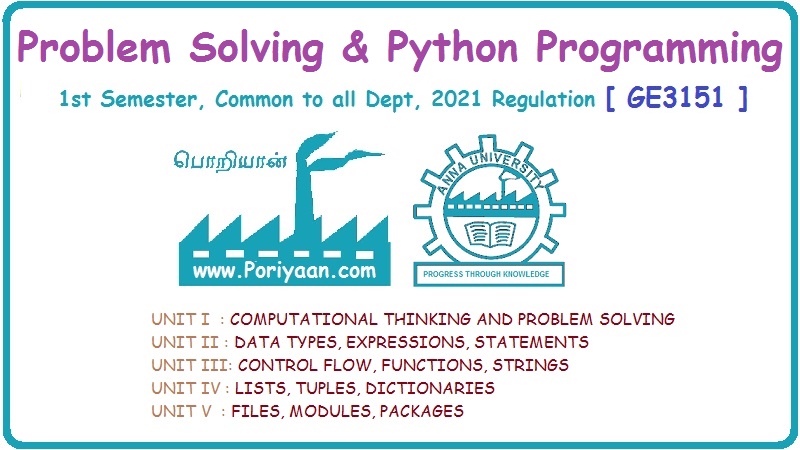Problem Solving and Python Programming: Laboratory Programs
Laboratory Python Programs Set 4
Problem Solving and Python Programming
Engineering Chemistry : UNIT V : Energy Sources and storage devices : Program for practice
Experiment
1: Write a Python Program to display current date and Time
import
datetime
now
= datetime.datetime.now()
print
("Current date and time :")
print
(now.strftime("%Y-%m-%d %H:%M:%S"))
Output
Current
date and time :
2018-04-10
10:58:53
Experiment
2: Write a Python Program to display Calendar
import
calendar
print("Enter
Year: ");
yy
= int(input())
print("Enter
month: ");
mm
= int(input());
print("\n",
calendar.month(yy,mm));
Output
Enter
Year:
2018
Enter
month:
4
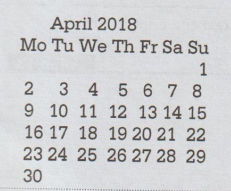
Experiment
3: Write a Python Program to check whether the input year is leap year or not
print("Enter
a year: ")
year
= int(input())
if
(year % 4) = = 0:
if
(year % 100) = = 0:
if
(year % 400) = = 0:
print("{0}
is a leap year".format(year))
else:
print("{0}
is not a leap year".format(year))
else:
print("{0}
is a leap year".format(year))
else:
print("{0}
is not a leap year".format(year))
Output
Enter
a year:
2016
2016
is a leap year
Experiment
4: Write a Python program to accept two numbers, multiply them and print the
result Jan 18
print("Enter
first number: ").
a
= int(input())
print("Enter
second number: ")
b
= int(input())
c
= a*b
print("The
multiplication is:",c)
Output
Enter
first number:
10
Enter
second number:
20
The multiplication is: 200
Experiment
5: Write a Python Program to accept two numbers, find the greatest and print
the result Jan 18
print("Enter
first number: ")
a
= int(input())
print("Enter
second number: ")
b
= int(input()) if a > b:
print("First
number is greater")
else:
print("Second
number is greater")
Output
Enter
first number:
10
Enter
second number:
20
Second
number is greater
Experiment
6: Write a Python program to implement simple calculator
def
add(x, y):
return
x + y
def
sub(x, y):
return
x - y
def
mult(x, y):
return
x * y
def
div(x, y):
return
x/y
print("Main
Menu")
print("1.Add")
print("2.Subtract")
print("3.
Multiply")
print("4.Divide")
print("Enter
your choice")
choice
= int(input())
print("Enter
first number")
num1
= int(input())
print("Enter
second number: ")
num2
= int(input())
if
choice = = 1:
print(num1,"+",num2,"=",
add(num1,num2))
elif
choice = = 2:
print(num1,"-",num2,"=",
sub(num1, num2))
elif
choice = = 3:
print(num
1, "*", num2,"=", mult(num1, num2))
elif
choice == 4:
print(num1,"7",num2,"=",
div(num1,num2))
else:
print("Invalid
input")
Output
Main
Menu
1.Add
2.
Subtract
3.Multiply
4.Divide
Enter your choice
1
Enter
first number
10
Enter
second number:
20
10
+ 20 = 30
Experiment
7 : Write a Python Program to check whether the number is positive, negative or
zero
print("Enter
some number")
num
= int(input())
if
num > 0:
print("Positive
number")
elif
num = = 0:
print("Zero")
else:
print("Negative
number")
Output(Run
1)
Enter
some number
4
Positive
number
Output(Run
2)
Enter
some number
-4
Negative
number
Output(Run
3)
Enter
some number
0
Zero
Experiment
8 : Write a Python program to find area of triangle(using Base and height)
print("Enter
base: ")
b
= float(input())
print("Enter
height: ")
h
= float(input())
area
= 0.5*b*h
print("The
area of triangle is: ", area)
Output
Enter
base:
10
Enter
height:
20
The
area of triangle is: 100.0
Experiment
9 : Write a Python program to find area of triangle(using three sides)
import
math
print("Enter
first side: ")
a
= float(input())
print("Enter
second side: ")
b
= float(input())
print("Enter
third side: ")
c
= float(input())
s
= (a+b+c)/2
area
= math.sqrt((s*(s-a)*(s-b)*(s-c)))
print("The
area of triangle is: "area)
Output
Enter
first side:
3
Enter
second side:
4
Enter
third side:
5
The
area of triangle is: 6.0
Experiment
10 : Write a Python Program to convert Celsius to Fahrenheit temperature
print("Enter
the celsius value: ")
celsius
= float(input())
fahrenheit
= (celsius * 1.8) + 32
print("Fahrenheit
value =",fahrenheit)
Output
Enter
the celsius value:
40.5
Fahrenheit
value = 104.9
Experiment
11 : Write a Python Program to convert Fahrenheit to Celsius temperature
print("Enter
the Fahrenheit value: ")
fahrenheit
= float(input())
celsius
= (fahrenheit - 32)/1.8
print("Celsius
value =",celsius)
Output
Enter
the Fahrenheit value:
104.9
Celsius
value = 40.5
Experiment
12: Write a Python Program to convert Kilometers to Miles
print("Enter
value in kilometers: ")
kilometers
= float(input()).
factor
= 0.621371
miles
= kilometers * factor
print("miles=
",miles)
Output
Enter
value in kilometers:
100
miles=
62.137100000000004
Experiment
13: Write a Python Program for finding L.C.M. of two numbers
a
= int(input("Enter first number: "))
b
= int(input("Enter second number: "))
if
a > b:
m
= a
else:
m
= b
while(True):
if((m
%a = = 0) and (m % b = = 0)):
lcm
= m
break
m
+ = 1
print("The
L.C.M. of", a, "and", b, "is",1cm)
Output
Enter
first number: 4
Enter
second number: 6
The
L.C.M. of 4 and 6 is 12
Experiment
14 : Write a Python Program to display GCD of two numbers
print("Enter
first number: ")
a
= int(input())
print("Enter
second number: ");
b
= int(input())
rem
= a%b
while
rem!=0 :
a
= b
b
= rem
rem
= a%b
print
("gcd of given numbers is: ",b)
Output
Enter
first number:
15
Enter
second number:
5
god
of given numbers is: 5
Experiment
15: Write a Python program to display all the prime numbers within the given
interval
print("Enter
the range (a,b)")
a
= int(input())
b=
print(input())
print("Prime
numbers between", a,"and", b,"are...")
for
num in range(a, b + 1):
#
prime numbers are greater than 1 if num > 1:
for
i in range(2,num):
if
(num %i) = = 0:
break
else:
print(num)
Output
Enter
the range [a, b]
1
10
Prime
numbers between 1 and 10 are...
2
3
5
7
Experiment
16 : Write a Python Program to print the factors of a given number
print("Enter
number: ")
num
= int(input())
print("The
factors of", num,"are...")
for
i in range(1, num + 1):
if
num %i = = 0:
print(i)
Output
Enter
number:
12
The
factors of 12 are...
1
2
3
4
6
12
Experiment
17 : Write a Python Program to convert decimal number to binary using recursion
def
DecToBin(n):
if
n > 1:
DecToBin(n//2)
print(n
% 2, end = ")
print("Enter
decimal number: ")
d
= int(input())
DecToBin(d)
Output
Enter
decimal number:
10
1010
Experiment
18 : Write a Python Program to perform addition of two matrices
A
= [[1,2,3],
[4,5,6],
[7,8,9]]
B
= [[11,12,13),
[14,15,16),
[17,18,19]]
C
= [[0,0,0],
[0,0,0],
[0,0,0]]
for
i in range(len(A)):
#
iterate through columns
for
j in range(len(A[0])):
C[i][j]
= A[i][j] + B[i][j]
print("Matrix
A..")
for
i in A:
print(i)
www
print("Matrix
B..")
for
j in B:
print()
print("The
addition of two matrices is..")
for
k in C:
print(k)
Output
Matrix
A..
[1,
2, 3]
[4,
5, 6]
[7,
8, 9]
Matrix
B..
[11,
12, 13]
[14,
15, 16]
[17,
18, 19]
The
addition of two matrices is..
[12,
14, 16]
[18,
20, 22]
[24,
26, 28]
Experiment
19: Write a Python Program to perform multiplication of two matrices
A
= [[1,2,3],
[4,5,6),
17,8,9]]
B
= [[11,12,13),
[14,15,16],
[17,18,19]]
C
= [[0,0,0],
[0,0,0],
[0,0,0]]
for
i in range(len(A)):
#iterate
through columns
for
j in range(len(A[0])):
for
k in range(len(B)):
C[i][j]+=
A[i][k] * B[k][j]
print("Matrix
A..")
for
i in A:
print(i)
print("Matrix
B..")
for
j in B:
print(j)
print("The
multiplication of two matrices is..")
for
k in C:
print(k)
Output
Matrix
A..
[1,
2, 3]
[4,
5, 6]
[7,
8, 9]
Matrix
B..
[11,
12, 13]
[14,
15, 16]
[17,
18, 19]
The
multiplication of two matrices is..
[90,
96, 102]
[216,
231, 246]
[342,
366, 390]
Experiment
20 : Write a Python Program to find the transpose of matrix
A
= [[1,2],
[3,
4],
[5,
6]]
B
= [[0, 0, 0],
[0,
0, 0]]
for
i in range(len(A)):
for
j in range(len(A[0])):
B[j][i]
= A[i][j]
print("Original
Matrix is...")
for
k in A:
print(k)
print("Transposed
Matrix is...")
for
k in B:
print(k)
Output
Original
Matrix is...
[1,
2]
[3,
4]
[5,
6]
Transposed
Matrix is...
[1,
3, 5]
[2,
4, 6]
Experiment
21 : Write a Python Program to find x' using recursion
def
power(x,y):
if(y
= = 1);
return(x)
if(y!=
1):
retum(x
* power(x,y-1)
x
= int(input "Enter base: "))
y
= int input("Enter exponential value: "))
print("Result:",
power(x,y))
Output
Enter
base: 2
Enter
exponential value: 3
Result:
8
Experiment
22 : Write a Python program to check if the number is Armstrong number
print("Enter
some number to check if it is Armstrong number: ")
num
= int(input())
total
= 0;
temp
= num;
while
temp > 0:
digit
= temp% 10;
total
+ = digit ** 3;
temp
// = 10;
if
num == total:
print(num,"is
an Armstrong Number.");
else:
print(num,"is
not an Armstrong Number.");
Output(Run
1)
Enter
some number to check if it is Armstrong number:
153
153
is an Armstrong Number.
Output(Run
2)
Enter
some number to check if it is Armstrong number:
101
101
is not an Armstrong Number.
Experiment
23 : Write a Python Program to find ASCII value of a character
ch
= input("Enter a character: ")
print("The
ASCII value of " + ch + "is",ord(ch))
Output
Enter
a character: A
The
ASCII value of 'A' is 65
Experiment
24 : Write a Python Program to display the ASCII values
print("The
ASCII values are...")
for
i in range(1, 255):
ch
= chr(i);
print(i,"=",
ch);
Experiment
25 : Write a Python Program to find palindrome of a given string
str
= 'madam'
#
reverse the string
rev_str
= reversed(str)
if
list(str) = = list(rev_str):
print("It
is palindrome")
else:
print("It
is not palindrome")
Output
It
is palindrome
Experiment
26 : Write a python Program to separate out and display the letters, digits and
special characters from the given string.
string
= input("Enter string:")
vowels
= 0
consonants
= 0
for
i in string:
if(i=
='a' or i = ='e' or i = ='i' or i = ='d' or i = ='u' or i = ='A' or i = ='E' or
i = =I' or i = ='0' or i = ='U');
vowels=vowels
+ 1
else:
consonants
= consonants +1
print("Number
of vowels are:")
print(vowels)
print("Number
of consonants are:")
print(consonants)
Output
Enter
string:hello
Number
of vowels are:
2
Number
of consonants are:
3
Experiment
27 : Write a Python Program to remove punctuation marks from the given string
punctuations
= "!()-[1{};:"'\,<>./?@#$%^&*_~"
str
= input("Enter a string: ")
result
= "
for
ch in str:
if
ch not in punctuations:
result
= result + ch
print("The
string after removing punctuations: "result)
Output
Enter
a string: hello!how are you? Bye.
The
string after removing punctuations: hellohow are you Bye
Experiment
28 : Write a Python Program to sort the words alphabetically from given string
str
= input("Enter a string: ")
words
= str.split()
words.sort()
print("The
sorted words are:")
for
word in words:
print(word)
Output
Enter
a string: Shilpa Archana Supriya
The
sorted words are:
Archana
Shilpa
Supriya
Experiment
29 : Write a Python Program to swap to strings
str1
= input("Enter First String: ");
str2
= input("Enter Second String: ");
print("\nBefore
swapping:");
print("First
String =",str1);
print("Second
String =",str2);
temp
= str1;
str1
= str2;
str2
= temp;
print("\nAfter
swapping:");
print("First
String =", str1);
print("Second
String =", str2);
Output
Enter
First String: aaa
Enter
Second String: bbb
Before
swapping:
First
String = aaa
Second
String = bbb
After
swapping:
First
String = bbb
Second
String = aaa
Experiment
30 : Write a Python Program to delete a desired word from given string
string
= input("Enter any string to remove particular word: ");
word
= input("Enter word to be deleted: ");
word_list
= string.split();
print(''.join([i
for i in word_list if i not in word]));
Output
Enter
any string to remove particular word: This is big Python program
Enter
word to be deleted: big
This
is Python program
Experiment
31 : Write a Python Program to remove a space from given string
str
= input("Enter some string with spaces in between: ");
new_string
= str.replace(" ", "');
print("\nNew
string after removing all spaces:");
print(new_string);
Output
Enter
some string with spaces in between: Hello Friend
New
string after removing all spaces:
HelloFriend
Experiment
32: Write a Python Program to display following pattern
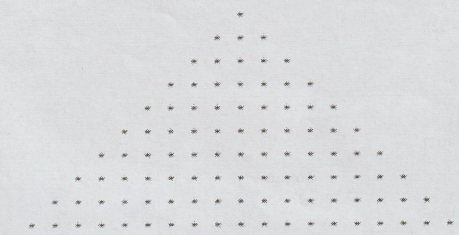
j
= 0
print("Enter
number of rows: ")
rows
= int(input())
for
i in range(1, rows+1):
for
space in range(1, (rows-i)+1):
print(end="
")
whilej
!= (2*i-1):
print("*
", end='')
j
= j + 1
j
= 0 print()
Output
Enter
number of rows:
10
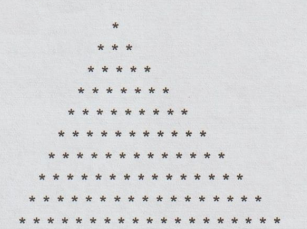
Experiment
33 : Write a Python Program to display a Pascal's Triangle
n
= int(input("Enter number of rows: "))
a
= [ ]
for
i in range(n):
a.append([
])
a[i].append(1)
for
j in range(1,1):
a[i].append(a[i-1][j-1]+a[i-1][j])
if(n!=0);
a[i].append(1)
for
i in range(n):
print("
*(n-i),end="",sep="")
for
j in range(0,i+1):
print('{0:5}'.format(a[i][j]),end="",sep="")
print()
Output
Enter
number of rows: 5
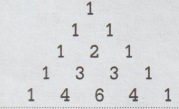
Experiment
34 : Write a Python Program to display Pascal's Triangle using List
print("Enter
number of rows: ")
row
= int(input())
list
= [1]
for
i in range(row):
print(list)
newlist
= [ ]
newlist.append(list[0])
for
i in range(len(list)-1):
newlist.append(list[i]+list[i+1])
newlist.append(list[-1])
list
= newlist
Output
Enter
number of rows:
5
[1]
[1,
11
[1,
2, 1]
[1,
3, 3, 1]
[1,
4, 6, 4, 1]
Experiment
35 : Write a Python Program to find the sum of all the elements in a List
def
sum_list(items):
total
= 0
for
x in items:
total
+ = x
return
total
print(sum_list([10,20,30,40]))
Output
100
Experiment
36: Write a Python Program to find the largest element from the List
def
Largest(items):
max_ele=items[0]
for
x in items:
if
x > max_ele:
max_ele
= x
return
max_ele
print(Largest([5,-1,100,2,30]))
Output
100
Experiment
37 : Write a Python Program to replace the last element of first list by the
entire second list elements
def
Replace_element(num1, num2):
num
1[-1:) = num2
print(num1)
num1
= [1, 2, 3, 4, 5]
num2
= (11, 12, 13, 14]
Replace_element(num1,num2)
Output
[1,
2, 3, 4, 11, 12, 13, 14]
Experiment
38 : Write a Python Program to accept a string from console and display the
characters present at even indexes.
def
display_even(str):
str
= str[::2]
print(str)
str
= input("Enter some string:")
display_even(str)
Output
Enter
some string: python
pto
Experiment
39 : Write a Python Program to iterate a list in reverse order
def
display_reverse(str):
str
= str[::-1]
print(str)
str
= input("Enter some string: ")
display_reverse(str)
Output
Enter
some string: python
nohtyp
Experiment
40 : Write a Python program to count number of characters in a string. Display
the character and its count. Make use of concept of dictionary.
def
display_char_count(str):
d
= {}
print("The
occurrences of characters are as follows ...")
for
s in str:
d[s]=d.get(s,0)+1
print
(d.items())
str
= input("Enter some string:")
display_char_count(str)
Output
Enter
some string: abccaade
The
occurrences of characters are as follows ...
dict_items([('a',
3), ('b', 1), ('c', 2), ('d', 1), ('e', 1)]).
Experiment
41 : Write a Python program to display a number from 1 to 10 along with its
square.Make use of concept of dictionary.
def
display_Square():
d
= dict()
for
i in range(1,11):
d[i]
= i*i
print
(d)
display_Square()
Output
{1:1,
2:4, 3:9, 4: 16, 5: 25, 6:36, 7: 49, 8: 64, 9: 81, 10: 100}
Experiment
42: Write a program to convert a tuple to string
def
display_Str( ):
t
= ('M', 'y', 'T', 'n', 'd','1', 'a')
st
r=".join(t) print(str)
display_Str(
)
Output
MyIndia
Experiment
43 : Write a Python program to create a tuple from a list of numbers from 1 to
10
def
Create_tuple():
li
= list()
for
i in range(1,11):
li.append(i)
print(tuple(li))
Create_tuple()
(1,2,3,4,5,6,7,8,9,10)
Experiment
44 : Write a Python program to create another tuple of even numbers from the
tuple containing the numbers from 1 to 10
def
Even_tuple():
t1
= (1,2,3,4,5,6,7,8,9,10)
li
= list()
for
i in t1:
if
i<10: if t1[i]%2 = = 0:
li.append(t1[i])
t2
= tuple(li)
print(t2)
Output
Even_tuple()
Output
(2,
4, 6, 8, 10)
Problem Solving and Python Programming: Laboratory Programs : Tag: Engineering Python : Problem Solving and Python Programming - Laboratory Python Programs Set 4
Related Topics
Related Subjects
Problem Solving and Python Programming
GE3151 1st Semester | 2021 Regulation | 1st Semester Common to all Dept 2021 Regulation
